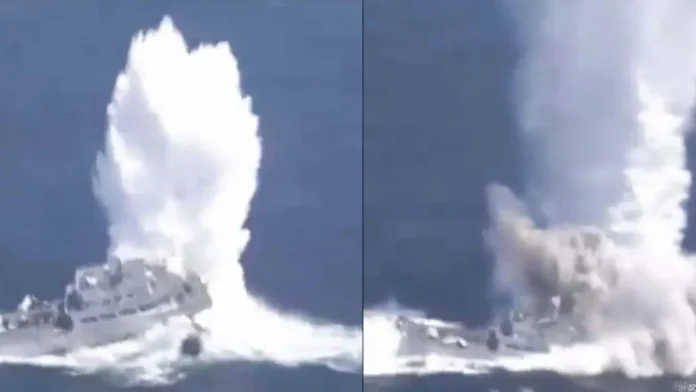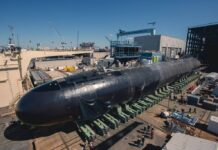
China has released a video highlighting its submarine force’s 70th anniversary. In it, we see a Type 074 (also called the Yuhai class) amphibious landing ship being attacked in a sinking exercise (SINKEX) or similar test. This is a rare glimpse into the effects of China’s submarine weapons capabilities, the WarZone reports.
The video was posted on China’s social media platform Weibo and a clip of it was also presented by our friend and close Chinese military watcher Alex Luck on X. From the looks of it, it appears to show the detonation of a wake-homing heavy torpedo. The indicators are where the weapon struck and the fact that the ship was underway, either via its own power or under tow, when it met its pre-planned end.
The video shows the torpedo detonating and ‘lifting’ the ship, which is an often catastrophic act that breaks the ship’s keel.
The Type 074s are an amphibious landing ship built in the late 1990s. There were 15 built, a dozen for the People’s Liberation Army Navy (PLAN), and a few others for export. Displacing 800 tons, the 191-foot ships could deliver two tanks or around 350 troops to the beach. These vessels are reaching the end of their service lives and are slowly being retired.
As a target, the Type 074 is an interesting choice based on its size and mission set, but hunting and killing landing craft similar to it is certainly within the realm of the PLAN attack submarine’s mission. Diesel-electric types, especially those with air-independent propulsion capabilities, are especially we suited for littoral combat operations and would hunt ships like this during an actual conflict.
Wake homing torpedoes are a major threat to any naval force. They are guided by bracketing the ship’s wake and literally swimming their way up to the ship’s stern — where critical components are often centralized — and detonating. These effects can come via long-range heavy torpedoes that pack formidable speed and explosive payload. From our previous post on modern attacks:
“Wake Homing is becoming more common on dual-purpose torpedoes today. Both 53cm and 65cm torpedoes can have wake homing logic, but the 65cm wake homing torpedoes are single purpose and specifically designed for this kind of attack.
65cm Wake homing torpedoes, like the Russian 65-76A, are large long-range torpedoes designed to search for a ship’s wake and follow it. 65cm torpedoes have enough fuel to travel in excess of 100 kilometers at 50 knots for just over an hour. This makes evasion a very time-consuming affair, allowing the attack submarine time to evade and re-engage. There are ways to actively defeat a wake homing torpedo, but a salvo of this kind of weapon is a carrier killer.”
The long range of some of these torpedoes greatly opens up the aperture of engagement zones for prowling submarines. For an area where a known amphibious operation is underway, sending these weapons into that area keeps the launching submarine relatively out of harms way while putting amphibious vessels at great risk.
The video in question shows a torpedo underwater and also has a statement from a submarine officer.The quotes provided in the post read as follows:
“Navy Submarine Force has made many historic breakthroughs #People’s Navy Submarine Force 70th Anniversary#. A certain submarine detachment of the Navy in the Northern Theater Command is the Navy’s first submarine force and also the “seed force” of submarines. Literary star of a submarine detachment of the Navy said: “At present, our torpedo attack and missile attack have made historic breakthroughs in the verification at sea. This means that our combat capabilities are stronger and our combat sea area is wider. When we are used, we are used, we are more capable. Have confidence.”
The war under the waves would be among the most critical domains of combat during a major fight in the Pacific. In many respects, the game of cat and mouse exists well outside of direct conflict on a daily basis. But in a real shooting war, submarines pose arguably one of the biggest threats to any naval force, as well as shipping. China has invested massively into its naval forces, including its increasingly advanced submarine force.
While the PLAN’s nuclear-powered types get the most attention, its diesel electric fleet that is more focused of protecting the inner sanctum of its territorial claims presents a massive problem for U.S. and allied navies and shipping. With new types coming to light and huge investments in unmanned undersea warfare, a facet of naval combat that could revolutionize how wars are fought beneath the waves, the threat posed by the PLAN’s submarine force only grows.
The timing is also interesting as the U.S. Navy’s massive international Rim of the Pacific (RIMPAC) war-games are about to kick-off in Hawaii and this time around it appears the sinking of a big-deck amphibious assault ship is on the program. Although the ship has been set aside for a SINKEX for some time, the optics could be interpreted, at least in part, as a message to China, which is investing heavily into these types of ships and the aircraft that will call them home.
Regardless, the video gives us a good look at what very well appears to be a wake homing torpedo in action and clearly it’s not something any sailor wouldn’t want to experience.



